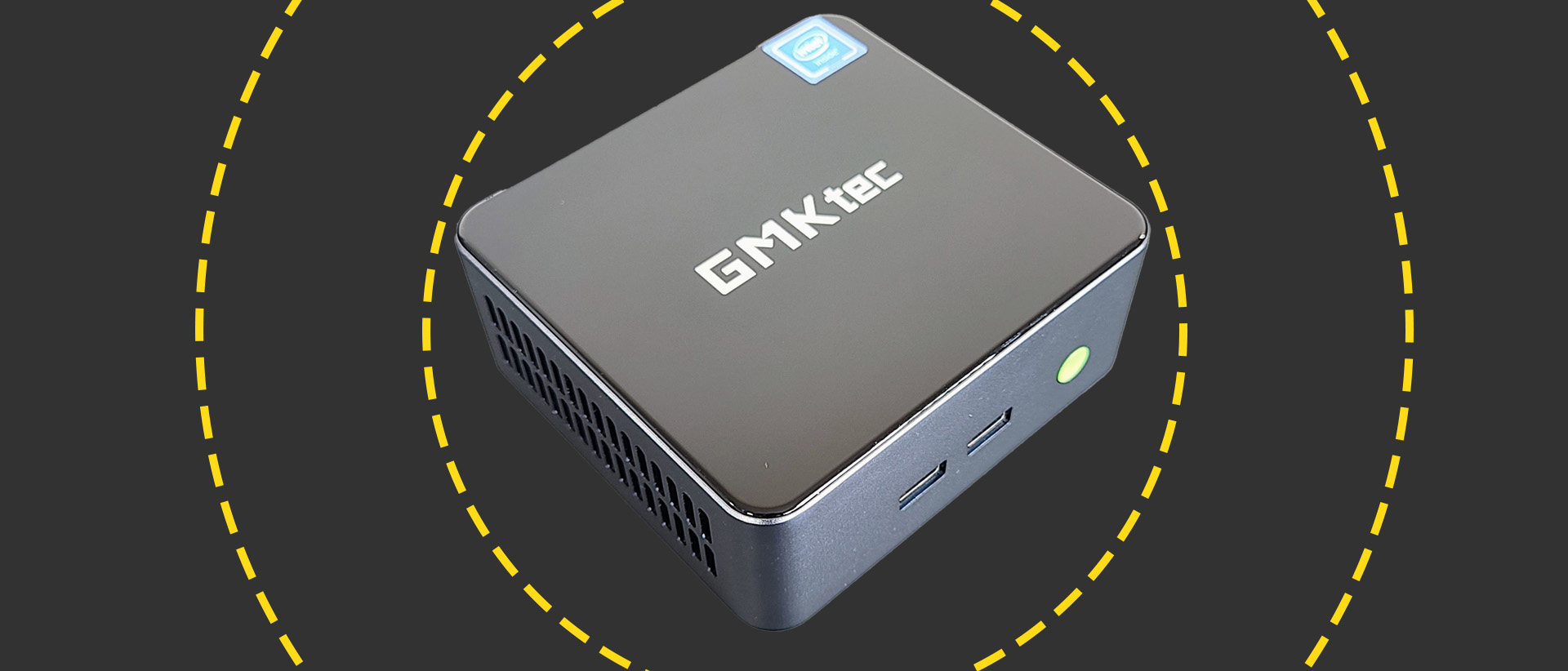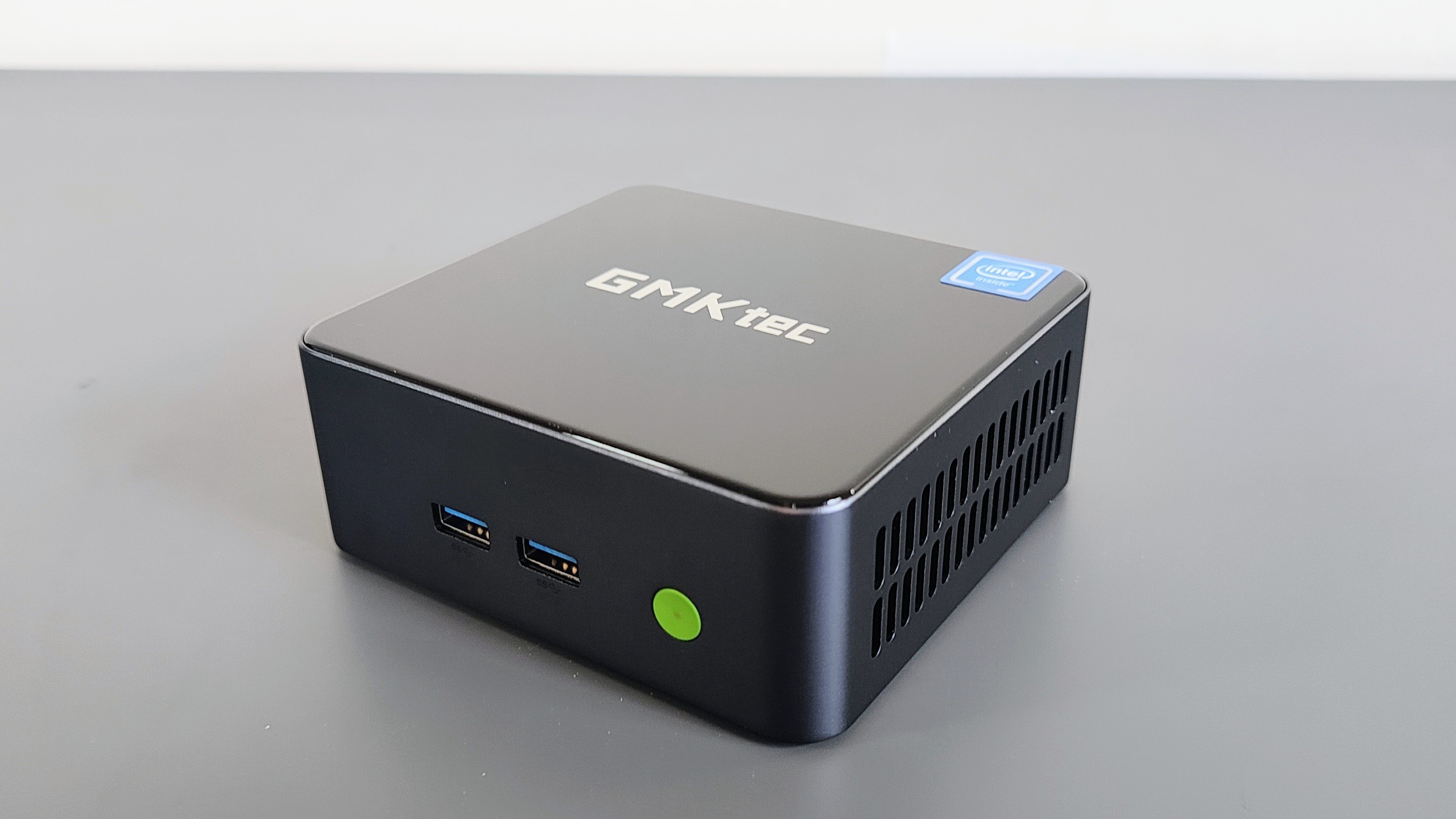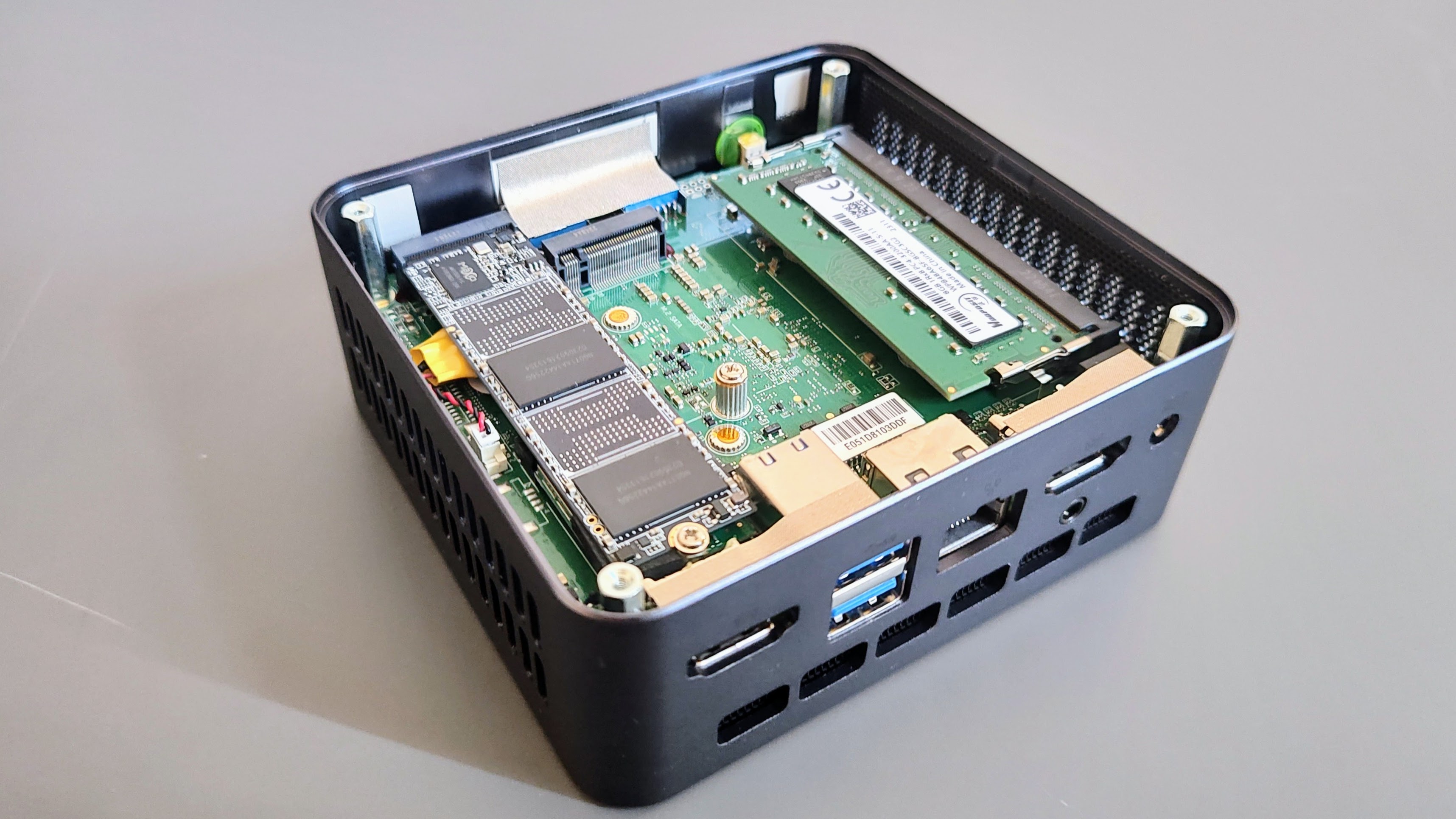GMKtec NucBox G1 review: A highly transportable, and affordable, Windows desktop PC
The GMKtec NucBox G1 is a cheap and cheerful small-form PC that's ideal as a thin client or an HTPC

-
+
Decent performance from the Intel N95 chipset
-
+
Very little fan noise
-
+
Easy to upgrade SSD and RAM
-
-
No DisplayPort or Type-C ports
-
-
No 6Ghz Wi-Fi
-
-
PCIe 3.0 SSD interface

Cheap, small-form PCs, such as the GMKtec NucBox G1, are all the rage at the moment and there is a wide selection of affordable models available from Chinese manufacturers who are not overly well-known in Europe like BeeLink, Chui, and Zotac to name but a few of the many.
These sorts of devices are not exactly new, we reviewed one of Intel's original NUC (that's Next Unit of Computing) boxes back in December 2012. It's a form factor Intel has stuck with, leading to the likes of the Nuc 11 which arrived two years ago. The Nuc 11 is more typical of the mid-range PCs built around Intel Core-i and AMD Ryzen silicon with prices to match, around the £400 – £500 mark while many of the Chinese boxes sit in a lower price category.
The G1 is the latest entry into the field from GMKtec (formerly just plain GMK) and sits very much at the budget end of the market. These cheaper devices certainly have their uses be it as thin-client platforms or home theatre PCs (HTPCs), drivers for digital displays or kiosks or just as highly transportable Windows desktop PCs.
GMKtec NucBox G1 review: Design
Slide the G1 out of its reassuringly deluxe box and you'll find a compact little affair measuring just 114 x 106 x 42mm. It feels well-made and perfectly solid while the 360g weight gives it some heft. The casing is made from milled aluminium with plastic panels on the top and bottom. The matte-finish grey paintwork on the sides do a good job of making it look and feel more expensive than it is.
On the front, there is a green illuminated power button and two Type-A USB ports while at the rear you'll find another two USB-A ports, two HDMI 2.0 connectors, a 3.5mm audio jack, 2.5G RJ45 Ethernet port and the DC-in jack. UK models come with a 3-pin wall charger. Both sides are taken up by exhaust grilles to let the single fan expel any warm air.

GMK has rather dropped the ball by not fitting the G1 with a DisplayPort video output, either full-sized or Type-C DP Alt Mode. Not having one limits the box's usability with mobile displays which often don't have an HDMI input.
GMKtec supplies a simple adapter bracket to mount the G1 to a VESA mount so you can hang it behind a monitor (in effect turning it into an all-in-one) or TV though finding space for something this small on your desk or TV stand is unlikely to be a problem.
Sign up today and you will receive a free copy of our Future Focus 2025 report - the leading guidance on AI, cybersecurity and other IT challenges as per 700+ senior executives
GMKtec NucBox G1 review: Specs and Performance
Inside the G1 you'll find a quad-core Intel N95 chip. This 15W TDP Alder Lake-N processor has four efficiency cores with a base clock of just 1.7GHz and a maximum boost speed of 3.4GHz.
Lithography is listed as Intel 7 which is a renaming of the Enhanced SuperFin 10nm fabrication technology rather than anything truly new but given that the transistor density in TSMC's 7nm roughly matches Intel's 10nm the new naming structure makes a degree of sense.

Memory comes in the form of 8GB of a single-channel DDR4-3200 SODIMM stick though you can also buy the G1 with a 16GB of RAM. For the record, the N95 processor only supports single-channel RAM.
In terms of performance, the N95 is a big step forward from the Celeron and Gemini Lake silicon that has typically been used in these types of small, cheap PCs like GMK's own NucBox 1 which runs on a J4125 CPU. They tended to be so puny that even the most undemanding tasks ran at a glacial pace while streaming 4K video smoothly was pretty much out of the question.
Clearly, the N95 isn't going to win any prizes for performance but the benchmark scores it generated were by no means a disgrace. The Geekbench 5 results of 989 and 2592 for single- and multi-core respectively are very close to the scores we got from an 8th generation Core i5-8250U-based Microsoft Surface Laptop 2 back in 2019 and we called its performance "very nippy indeed".
Our in-house 4K multi-media benchmark scored 83 (again, comparable to a 2019-vintage Dell XPS 13) points while the Cinebench R23 test managed 2170 multi-core and 839 single-core. For an entry-level budget chipset, they are decent scores and show that while the G1 won't exactly fly through productivity tasks it won't bog down either.
The LatencyMon app showed no DPC latency issues when opening multiple web browser tabs, something that was often an issue with systems running on Celeron and Gemini Lake silicon and 4K video playback at 60 FPS on YouTube was perfectly reliable with no dropped frames during a 15-minute run-through.
The integrated Intel UHD graphics processor is based on the Xe-architecture but is made up of only 16 Tiger-Lake H execution units running at 1200 MHz which means that the graphics performance is very limited. The 3DMark Time Spy benchmark refused to run on the G1 while the GFXBench Car Chase and Manhattan 1080p offscreen tests ran at 26fps and 66fps respectively which is very low if not lower than we expected. The G1 can however drive two screens at up to 4K 60Hz without drama which in this context is probably more important than outright graphics performance.
Wireless communications are handled by a RealTek 8852BE card that only supports the 2.5GHz and 5GHz wavelengths in Wi-Fi 6. The chip averaged over 625 Mb/s in our iPerf3 Client Wi-Fi tests which is adequate for streaming needs even if it can't match the sort of speeds we'd expect from Intel's ubiquitous AX201 card.
Should you need more speed the RJ-45 port is always available for faster network throughput. It's rated at 2.5GbE though I only managed to get 1GbE performance when I tested it.
The Maxio SSD in our review unit managed sequential read and write speeds of 1,435MB/s and 1,380MB/s respectively which is satisfactory for a system that is unlikely to be bought with the intention of moving massive amounts of data about.
We don't usually measure the power draw of devices but with the G1 we thought it was worthwhile: The highest peak figure we saw while running our 4K benchmark was 23.6W which shouldn't trouble anyone's power supply.
GMKtec NucBox G1 review: Features
Opening up the G1 is simple: just undo the four Philips screws that secure the base plate and then lift it out of the chassis. Once done you have easy access to the SODIMM slot, the 2280 PCIe 3 SSD and the mount for a 2242 mSATA SSD. That last may seem a bit old-school, but when you can pick up a 1TB card for £85 it makes sense as a way of adding affordable bulk storage that's fast enough for the sort of work the G1 is destined to do.

While the option to add extra storage is welcome the absence of a card reader of any sort is not. Given the likely usage scenarios for the G1 a MicroSD card reader would have been a worthwhile addition.
With a view to the business user the G1 ships with Windows 11 Pro rather than Home which was rather unexpected. While you can't buy the G1 without Windows GMKtec says that it will support most popular Linux distros however when we tried Ubuntu 22.04 off a bootable USB the Wi-Fi radio wasn't recognised. This seems to be a common issue with the Realtek network card used in the G1 so be prepared to have to tinker with the drivers to get it working.
While many cheap small-form PCs like the G1 are passively cooled the G1 has a single fan. This ensures that thermal throttling is never a problem for the 15W TDP processor so you can run it hard for hours on end. If you have the G1 close by you can hear the fan spinning at full speed though the sound is not what you could call intrusive. Put the G1 more than a meter away or behind a monitor panel and it's close to inaudible.
GMKtec NucBox G1 review: Purchasing
For buyers outside the USA G1 is only available direct from GMKtec with a current price of $239 with 8GB of RAM and $279 with 16GB. That equates to around £170 ex-VAT which is cheap for a Windows 11 PC running on silicon that's not entry-level or several years past its sell-by date. At the time of writing, there is also a $50 discount offer on the site which drops the price of the cheaper model closer to £150. Buyers in the USA can purchase the G1 from Amazon for $199 for the 8GB model and again at the time of writing there is a $20 discount coupon showing.
That's solid value given that you are getting an up-to-date Intel chip into the bargain. Look at it this way, you can buy a G1 and an MSI MP273QP 27-inch monitor, screw them together and get a decent all-in-one for less than £350. Buying from a smaller OEM always raises issues of after-sales support but there's really not much to go wrong with a device this simple.
GMKtec NucBox G1 review: Specifications
| Processor | Intel N95 3.4Ghz Quad-core |
| RAM | 8GB DDR4 3,200MHz |
| I/O Ports | USB-A 3.2 Gen 1 x 4, RJ45 2.5GbE LAN x 1 |
| Video Output | HDMI 2.0 x 2 |
| 3.5mm audio jack | Yes |
| Storage | 512GB M.2 PCIe 3 2280 SSD |
| Wi-Fi | Wi-Fi 6 5Ghz |
| Bluetooth | Wi-Fi 6 5Ghz |
| Weight | 360g |
| Size | 114 x 106 x 42.5 |
| Operating System | Windows 11 Pro |
Over the years, Alun has written freelance for several online publications on subjects ranging from mobile phones to digital audio equipment and PCs and from electric cars to industrial heritage. Before becoming a technology writer, he worked at Sony Music for 15 years. Quite what either occupation has to do with the degree in Early Medieval History he read at the University of Leeds is a bit of a grey area. A native of Scotland but an adopted Mancunian, Alun divides his time between writing, listening to live music, dreaming of the glens and dealing with an unhinged Norwegian Elkhound. For ITPro, Alun reviews laptops and PCs from brands such as Acer, Asus, Lenovo, Dell and HP.
-
 Qualcomm the data center with $2.4 billion Alphawave Semi acquisition
Qualcomm the data center with $2.4 billion Alphawave Semi acquisitionNews The move sees Qualcomm absorb Alphawave Semi’s portfolio of custom silicon, high-speed connectivity solutions, and chiplets
By Daniel Todd Published
-
 ‘If software development were an F1 race, these inefficiencies are the pit stops that eat into lap time’: Why developers need to sharpen their focus on documentation
‘If software development were an F1 race, these inefficiencies are the pit stops that eat into lap time’: Why developers need to sharpen their focus on documentationNews Poor documentation is a leading frustration for developers, research shows, but many are shirking responsibilities – and it's having a huge impact on efficiency.
By Ross Kelly Published
-
 OpenAI says GPT-5.2-Codex is its ‘most advanced agentic coding model yet’ – here’s what developers and cyber teams can expect
OpenAI says GPT-5.2-Codex is its ‘most advanced agentic coding model yet’ – here’s what developers and cyber teams can expectNews GPT-5.2 Codex is available immediately for paid ChatGPT users and API access will be rolled out in “coming weeks”
By Ross Kelly Published
